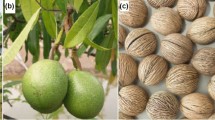Abstract
The present study reveals the effect of pendant functional groups on curing and final properties of cardanol-derived benzoxazines. Three benzoxazines are synthesized by choosing three functional amines, namely aniline, 4-aminophenol, and 4-aminobenzoic acid. The structure of the benzoxazines is confirmed by chemical as well as spectroscopic analysis. Curing kinetics of benzoxazines is studied using nonisothermal differential scanning calorimetry (DSC) at four different heating rates: 5, 10, 15, and 20 degrees per minute. Further, kinetic models of Kissinger and Flynn–Wall–Ozawa are applied to determine the kinetic parameters of the curing reaction. Curing kinetics and modeling studies reveal that benzoxazine containing phenolic OH requires lower energy of activation for curing as compared to carboxyl functional benzoxazine and neat benzoxazine. Moreover, coatings are applied on mild steel (MS) panels and evaluated for mechanical, chemical, and thermal properties.
Graphical Abstract

















Similar content being viewed by others
References
Calo, E, Maffezzoli, A, Mele, G, Martina, F, Mazzetto, SE, Tarzia, A, Stifani, C, “Synthesis of a Novel Cardanol-based Benzoxazine Monomer and Environmentally Sustainable Production of Polymers and Bio-Composites.” Green Chem., 9 754–759 (2007)
Jubsilp, C, Punson, K, Takeichi, T, Rimdusit, S, “Curing Kinetics of Benzoxazine Epoxy Copolymer Investigated by Non-isothermal Differential Scanning Calorimetry.” Polym. Degrad. Stab., 95 918–924 (2010)
Andreu, R, Espinosa, MA, Galia, M, Cadiz, V, Ronda, JC, Reina, JA, “Synthesis of Novel Benzoxazines Containing Glycidyl Groups: A Study of the Crosslinking Behaviour.” J. Polym. Sci. Part A Polym. Chem., 44 1529–1540 (2006)
Rucigaj, A, Alic, B, Krajnc, M, Sebenik, U, “Curing of Bisphenol A-Aniline Based Benzoxazine Using Phenolic, Amino and Mercapto Accelerators.” eXPRESS Polym. Lett., 9 647–657 (2015)
Sun, JQ, Wei, W, Xu, Y, Qu, J, Liu, X, Endo, T, “A Curing System of Benzoxazine with Amine: Reactivity, Reaction Mechanism and Material Properties.” RSC Adv., 5 19048–19057 (2005)
Liu, YL, Yu, JM, “Cocuring Behaviors of Benzoxazine and Maleimide Derivatives and the Thermal Properties of the Cured Products.” J. Polym. Sci. Part A Polym. Chem., 44 1890–1899 (2006)
Cheng, Y, Kong, L, Ren, Z, Qi, T, “Highly Cross-Linked Thermosetting Benzocyclobutene-Modified bis-Benzoxazine Resins from 4-Hydroxybenzocyclobutene.” High Perform. Polym., 25 980 (2013)
Cheng, Y, Yang, J, Jin, Y, Deng, D, Xiao, F, “Synthesis and Properties of Highly Cross-Linked Thermosetting Resins of Benzocyclobutene-Functionalized Benzoxazine.” Macromolecules, 45 4085 (2012)
Cheng, Y, Qi, T, Jin, Y, Deng, D, Xiao, F, “Highly Cross-Linked Thermosetting Resin of Maleimidobenzoxazine Functionalized with Benzocyclobutene.” Polymer, 54 143 (2013)
Chang, HC, Lin, HT, Lin, CH, “Benzoxazine-Based Phosphinated Bisphenols and Their Application in Preparing Flame-Retardant, Low Dielectric Cyanate Ester Thermosets.” Polym. Chem., 3 970 (2012)
Kiskan, B, Koz, B, Yagci, Y, “Synthesis and Characterization of Fluid 1,3-Benzoxazine Monomers and Their Thermally Activated Curing.” J. Polym. Sci. Part A Polym. Chem., 47 6955 (2009)
Kudoh, R, Sudo, A, Endo, T, “A Highly Reactive Benzoxazine Monomer, 1-(2-Hydroxyethyl)-1, 3-Benzoxazine: Activation of Benzoxazine by Neighboring Group Participation of Hydroxyl Group.” Macromolecules, 43 1185 (2010)
Li, SF, Zou, T, “Synthesis, Characterization of New Carboxylic Acid-Containing Benzoxazine and Its Cocuring Behaviors with Bisoxazoline.” J. Appl. Polym. Sci., 123 922 (2012)
Oie, H, Sudo, A, Endo, T, “Acceleration Effect of N-Allyl Group on Thermally Induced Ring Opening Polybenzoxazine of 1,3-Benzoxazine.” J. Polym. Sci. Part A Polym. Chem., 48 5357 (2010)
Chernykh, A, Agag, T, Ishida, H, “Effect of Polymerizing Diacetylene Groups on the Lowering of Polymerization Temperature of Benzoxazine Groups in the Highly Thermally Stable Main-Chain-Type Polybenzoxazines.” Macromolecules, 42 5121 (2009)
Demir, KD, Kiskan, B, Yagci, Y, “Thermally Curable Acetylene-Containing Main-Chain Benzoxazine Polymers via Sonogashira Coupling Reaction.” Macromolecules, 44 1801 (2011)
Lochab, B, Varma, IK, Bijwe, J, “Thermal Behaviour of Cardanol-Based Benzoxazines Monomers and Polymers.” J. Therm. Anal. Calorim., 102 769–774 (2010)
Sbirrazzuoli, N, Vyazovkin, S, “Learning About Epoxy Cure Mechanisms from Isoconversional Analysis of DSC Data.” Thermochim. Acta, 388 289–298 (2002)
Ishida, H, Rodriguez, Y, “Curing Kinetics of a New Benzoxazine-Based Phenolic Resin by Differential Scanning Calorimetry.” Polymer, 36 3151 (1995)
Sbirrazzuoli, N, Girault, Y, Elégant, L, “Simulations for Evaluation of Kinetic Methods in Differential Scanning Calorimetry—Part 3—Peak Maximum Evolution Methods and Isoconversional Methods.” Thermochim. Acta, 293 25–37 (1997)
Málek, J, “A Computer Program for Kinetic Analysis of Non-isothermal Thermo Analytical Data.” Thermochim. Acta, 138 337–346 (1989)
Evgeny, D, Taisa, D, “Dissociation Energies of O − H Bonds of Phenols and Hydroperoxides.” In: Tadashi, M (ed.) Application of Thermodynamics to Biological and Materials Science, pp. 405–412. InTech Publisher, Rijeka (2011)
Blanksby, SJ, Ellison, GB, “Bond Dissociation Energies of Organic Molecules.” Acc. Chem. Res., 36 (4) 255–263 (2002)
DeRuiter, J, “Carboxylic Acid Structure and Chemistry: Part 1.” In: Principles of Drug Action 1. Auburn University, Auburn (2005)
Shirvastva, AK, Jain, PC, Chemistry: Alcohols, Phenols and Ethers, p. 919. VK Enterprises, India, 2008
Rao, BS, Palanisamy, A, “Synthesis of Bio Based Low Temperature Curable Liquid Epoxy, Benzoxazine Monomer System from Cardanol: Thermal and Viscoelastic Properties.” Eur. Polymer J., 49 2365–2376 (2013)
Rao, BS, Palanisamy, A, “Monofunctional Benzoxazine from Cardanol for Bio-composite Applications.” React. Funct. Polym., 71 148–154 (2011)
Arnebold, A, Schorsch, O, Stelten, J, Hartwig, A, “Resorcinol-Based Benzoxazine with Low Polymerization Temperature.” J. Polym. Sci. Part A Polym. Chem., 52 1693–1699 (2014)
Andreu, R, Reina, JA, Ronda, JC, “Carboxylic Acid-Containing Benzoxazines as Efficient Catalysts in the Thermal Polymerization of Benzoxazines.” J. Polym. Sci. Part A Polym. Chem., 46 6091–6101 (2008)
Acknowledgments
The authors would like to thank Cardolite Specialty Chemicals, India, for providing NC-700 sample. The authors would like to thank Ms. Sonali (IIT Bombay, India) for providing proton NMR analysis of products. This research was funded by UGC-BSR [F.25-1/2014-15 (BSR)/No. F.7-314/2010(BSR)].
Author information
Authors and Affiliations
Corresponding author
Electronic supplementary material
Below is the link to the electronic supplementary material.
Rights and permissions
About this article
Cite this article
Wazarkar, K., Sabnis, A. Effect of pendant functional groups on curing kinetics and final properties of cardanol-based benzoxazines. J Coat Technol Res 15, 555–569 (2018). https://doi.org/10.1007/s11998-017-0020-9
Published:
Issue Date:
DOI: https://doi.org/10.1007/s11998-017-0020-9




